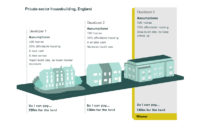Last week, through the case of Hornsey Town Hall, we highlighted once again how a lack of transparency for viability assessments is contributing to the loss of affordable homes across England.
In London, however, the Mayor is listening and progress is being made in the form of a new piece of supplementary planning guidance (SPG).
This guidance – Homes for Londoners Affordable Housing and Viability Supplementary Planning Guidance 2017 – seeks to increase transparency around viability and increase the numbers of affordable homes being provided on new developments. If successful it could be a real step forward in stopping developers overpaying for land and then squeezing down affordable homes to maximise profit.

So what will this guidance do?
The new guidance will act as an update to the current London Plan. Many of the measures are extremely positive – and go in exactly the direction Shelter have been arguing for, such as:
- A threshold approach to viability assessments – With a fast track to consent where affordability targets are met
- Clear guidance for viability assessments – A standardised approach will introduce much needed consistency across London, and potentially bring land into development at lower values, reducing prices and rents
- Greater transparency – Public viability assessments enable public scrutiny. Quite clearly something we should be expecting
Of course, as with all things, the SPG isn’t perfect. In particular, when it comes to identifying land value – a key element of viability.
Currently, when developers use viability assessments to argue down affordable housing contributions, two figures matter:
- The benchmark land value – a price below which a landowner would not sell
- The residual land value – the price the developer has paid for the land
If the residual land value is greater than the benchmark land value, the scheme is profitable for the landowner. However, if there is no difference or the difference is not large enough, the developer can start cutting costs – including the amount of affordable housing.
This creates a problem: Developers can overpay for land knowing that they can use viability to argue down affordable housing to recoup that overpayment without impacting their profit. Essentially ignoring the local planning requirements because they know they can get out of them.
And this system is what we highlight as broken in our New Civic Housebuilding report, which also sets out an alternative to this status quo. A better way to value land, one that actually ensured developers don’t overpay knowing they can save elsewhere, will mean more realistic land prices and the delivery of more affordable homes.
In the SPG, the Mayor has tried to make it clear that viability assessments should calculate the benchmark using Existing Use Value Plus (EUV+). This is essentially what the land is worth in its current state with an added premium that would be the landowner’s incentive to sell.
This approach is something we wholeheartedly agree with and that would be a great improvement on the current system.
Unfortunately, the Mayor has allowed for “limited circumstances” where a market value approach “may be appropriate”. This is a step back from the original draft and could leave the door ajar for exploitation by some developers.
We trust that the Mayor and the GLA will work hard to prevent any abuse and ensure affordable housing is delivered. Yet, leaving room for manoeuvre may be all some developers need.
That’s the detail of course. Boiled down, what the Mayor is trying to do is exactly what we and others have been calling for: get more affordable homes built and increase transparency, consistency and scrutiny around viability.
And, frankly, he’s made a really good effort.
Overall, is it problem solved?
Simple answer: No. But it’s a really positive step by a Mayor with powers that are limited in this area.
One challenge is that guidance is just that, guidance. In some circumstances the Mayor can enforce this approach. However, where London boroughs act as the local planning authority they are not obligated to follow the guidance provided by the Mayor – although many likely will.
In addition, it may be that developers continue to use viability to try and argue down affordable housing. Standardisation and public scrutiny may not deter attempts by some to reduce contributions.
What else do we need?
We need to address this problem across England and introduce a national approach to viability. This would ensure certainty for developers, local planning authorities and local people. As we outlined in New Civic Housebuilding what this means is:
- Minimum affordable housing contributions enforced by local authorities, with fast-tracked planning permission for compliant schemes
- All viability assessments fully public and published online
- Viability assessments standardised, with schemes judged based on paying for land at existing use value plus a premium
- The National Planning Policy Framework updated to remove the obligation for schemes to deliver “competitive returns” to developers
This SPG takes us in a great direction. What is now needed is support from national and local government to make transparency and consistency the norm.
